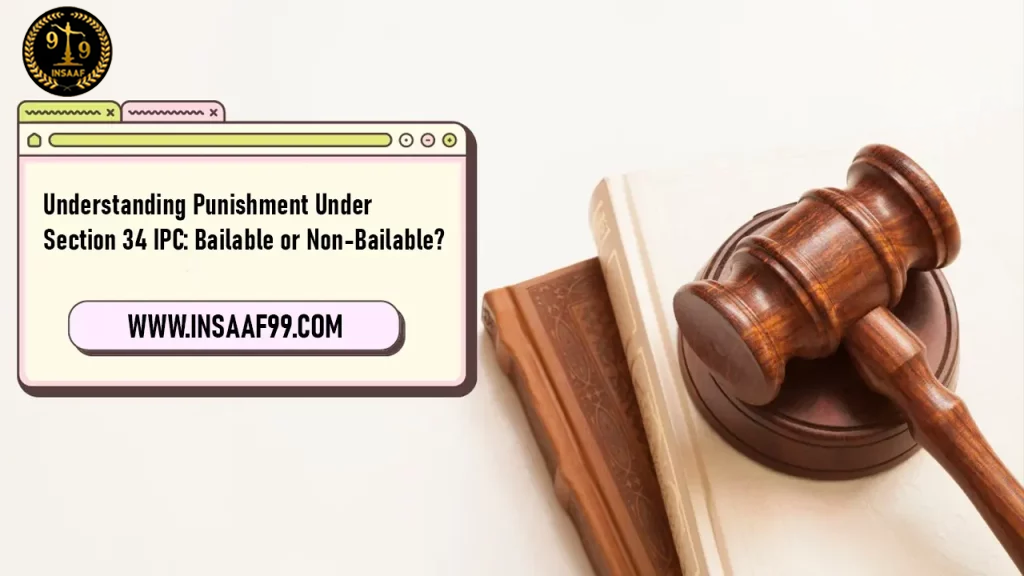

Online Legal Advice from Insaaf99® Online Lawyer Consultation in India


Online Legal Advice from Insaaf99® Online Lawyer Consultation in India

Under Section 34 IPC of the Indian Penal Code (IPC) plays a pivotal role in criminal law, emphasizing common intention among individuals committing a crime. It holds that when multiple individuals act with a shared criminal intent, each is held individually responsible for the offense.
However, the classification of offenses under Section 34 is bailable or non-bailable is a matter subject to legal interpretation and ongoing debate. Let us delve into the intricacies of Section 34 IPC, shedding light on its implications and the associated question of bail provisions.
Understanding the implications of Section-34 IPC is vital for both legal practitioners and the general public to navigate the intricacies of criminal law in India.
Section 34 of the Indian Penal Code (IPC) addresses joint liability for crimes committed with a common intention. It applies when multiple individuals engage in a criminal act, sharing the same criminal intent and making each person equally liable for the consequences.
Common intention can be formed before or during the crime, inferred from the conduct of the individuals. This section is frequently used when crimes involve a group, playing a crucial role in attributing criminal liability to all participants.
The classification of an offense under Section-34 IPC is bailable or non-bailable hinges on the nature and severity of the crime. A "bailable" offense allows the accused to seek bail as a matter of right, while "non-bailable" offenses necessitate the accused to apply for bail, subject to the court's discretion in granting or denying it.
If the offense committed under Section 34 IPC is categorized as a bailable offense, the accused individuals have the right to apply for bail. This allows them to be released from custody by providing a surety or bond to the court. The court may grant bail if it is satisfied that the accused individuals are unlikely to abscond or interfere with the investigation or trial.
Also Read: - Constitutional Dynamics: Fundamental Rights and Duties in India
If the offense under Section-34 IPC is classified as a non-bailable offense, the accused individuals do not have an automatic right to bail. Non-bailable offenses are considered more serious in nature, and the accused may need to present compelling reasons to the court to secure bail.
The court will evaluate factors such as the seriousness of the offense, the risk of absconding, and the potential interference with the investigation or trial before deciding on bail.

In cases involving offenses under Section 34 IPC, bail decisions are influenced by various factors:
Nature of the Offense: The severity of the committed crime is a crucial factor. More serious offenses are less likely to result in bail.
Evidence against the Accused: The strength of the evidence is considered. Strong evidence may reduce the likelihood of bail.
Criminal History: The accused individuals' past criminal activities are assessed. A history of serious offenses may impact the bail decision.
Likelihood of Absconding: The court evaluates the probability of the accused individuals fleeing. Ties to the community and financial stability are considered.
Possibility of Interfering with the Investigation or Trial: The court assesses whether the accused individuals may disrupt the investigation or trial, including witness intimidation or evidence tampering.
Legal Precedents: Legal precedents and judgments have played a pivotal role in interpreting Section 34 IPC. Courts consistently emphasize the need for evidence establishing a common intention among accused individuals to commit a criminal act.
A. K M Nanavati v. State of Maharashtra (1962):
In this high-profile murder case, Commander K M Nanavati's trial marked a significant application of Section 34 IPC. Despite Nanavati acting individually, the Supreme Court emphasized the necessity of proving a collective intent among the accused. This landmark case highlighted the collaborative nature of criminal acts under Section 34.
B. Bachan Singh v. State of Punjab (1982):
The Bachan Singh case clarified prerequisites for invoking Section 34 IPC. Addressing a joint criminal venture resulting in murder, the Supreme Court emphasized the crucial need for a shared intention among the accused. This decision set a precedent, shaping the understanding of Section 34 and its application in cases involving collective criminal activities.
In conclusion, Section 34 of the IPC is a vital legal provision that intertwines individual culpability in collective criminal acts. Deciphering the bailable vs. non-bailable intricacies within the context of Section 34 demands a comprehensive grasp of legal principles, as exemplified by landmark cases and evolving jurisprudence.
A nuanced understanding of Section 34 IPC ensures that justice is served while respecting the rights of the accused, reflecting the dynamic nature of the legal landscape.
Insaaf99 serves as a beacon for those entangled in Section 34 IPC cases, providing swift access to the best legal minds. Our platform ensures expert guidance by connecting individuals with seasoned criminal lawyers adept at navigating collective criminal liabilities.
With a curated pool of legal professionals, Insaaf99 facilitates personalized consultations, aiding clients in understanding the nuances of Section 34 and strategizing their defense. The convenience of online consultations eliminates geographical barriers, offering tailored legal solutions.
Insaaf99 stands as a reliable ally, empowering individuals facing Section 34 IPC challenges to secure Legal advice, strategic representation, and unwavering support throughout their legal journey.